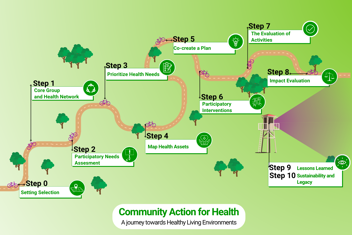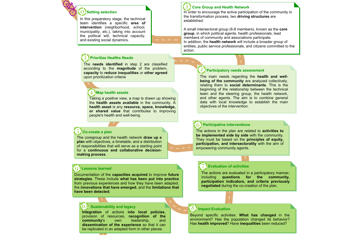The Joint Action PreventNCD is developing 51 interventions —spread across 15 countries— to make living environments healthier places. This is one of the key commitments to tackling the incidence of non-communicable diseases (NCDs) in Europe. Scientific evidence shows that scientific evidence shows that health is not only created in hospitals and doctors' offices, but also takes place in streets, schools, homes, urban spaces and in the social relationships we establish. Put simply, our health is determined by the environment we live and interact with on a daily basis.
The collaborative work of communities with politicians and technicians from different municipal sectors such as urban planning, education, youth, etc. is absolutely essential when developing collective action to find common solutions to improve the health of the people and those facing diseases such as obesity, cardiovascular disease, or cancer living in this municipality, encouraging the proximity of the solutions. With the aim of catalysing a change in our living environments, the activities being carried out are focused on four action areas: establishment of child support communities and health services adapted to infants, facilitating access to healthier products, promoting healthier urban spaces and transforming environments to eliminate the presence of unhealthy products. This transformation permeates all stages of life and identify approaches to increase health equity among social groups.
The complexity of coordinating such diverse actions —and in so many different places— requires a common methodology that harmonizes the work carried out in all the interventions. This approach will be summarised in the document A Guide to the Community Action Methodology and will be published in the Resources section of this website. It is a living working document that will be enriched with the experience gained during the implementation of the project. The guide will be published in a final interactive version on a capacity building platform together with the experiences of the different pilots in each step, the lessons learned, a selection of participative tools to help the work in each step and ready-to-use presentation slides. Overall, the goal is to become the decisive turning point in reducing the burden of NCDs.

Community action in health promotion
"Health is created and experienced by people in the context of their daily lives, where they learn, work, play, and love", this is how the Ottawa Charter defines the relationship between health and living environments. The characteristics of the environment in which we live that impact on our health status are known as the Social Determinants of Health.
For example, a family living in a neighbourhood with few green spaces and safe areas to play will find it more difficult for their children to develop regular physical activity habits, which increases the risk of NCDs such as childhood obesity and cardiovascular problems when becoming an adult. Similarly, in areas where the main food options are fast food establishments or stores selling ultra-processed products, it is much more difficult to maintain a healthy diet. On the contrary, neighbourhoods with local markets and easy access to fresh fruit and vegetables facilitate healthier choices for the whole community.
Empowering communities to take ownership of their environment and collectively work with their policy makers to transform their daily realities is a successful strategy for improving population health. In fact, scientific evidence shows that community-based interventions achieve significant improvements in healthy behaviours, social support and self-efficacy, establishing themselves as an effective way to transform the social determinants of health as well as those of the living environment. In order for communities to be able to do this, they must be supported from the national and European level through adequate resources, policy frameworks and capacity building.
A journey towards healthy living environments
The Methodological Guide is organized into 11 steps that include defining the environment of action, the formation of alliances with different reference groups in the community with whom to co-design action plans, the implementation of activities, and the joint evaluation of changes in health. Each step provides clear guidance with practical examples and recommendations on how to act considering the local conditions of each intervention. All interventions share this same framework, regardless of their specific objective or local setting – be it an intervention focused on establishing a breastfeeding support community or the creation of a car-free area at school surroundings to achieve a safer area with healthier air.

Applying theory to tangible realities, we can imagine interventions such as the creation of a community program of outdoor physical activity in the municipality's squares and parks, co-designed with sports organizations, municipal urban planners and neighbourhood associations. After identifying the lack of affordable options for staying active, sports clubs and municipal facilities are mapped, regular activities are planned, and the impact on the well-being of participants is evaluated.
A second example could be the implementation of a market for fresh local produce in a neighbourhood with limited access to healthy food: the intervention starts with a participatory assessment of needs, brings together the municipal decision maker, local organizations and businesses as active participants and culminates in the launch of a permanent healthy food market. The community contributes itself to monitor its use and enjoys the benefits of easy access to healthier food.
This is the transformation of living environments proposed by JA PreventNCD.
More than just words
This methodology is designed not to be forgotten in a drawer or computer file folder. It is the common thread of dozens of interventions that are being carried out, here and now, in different parts of Europe. The document itself is alive and will be updated with the experience gained at each stage.
All these resources and experiences will be compiled and organized in a user-friendly capacity building platform. This platform will form the basis for replicating and improving the experiences carried out throughout the European Union and, hopefully, the rest of the world. A space for knowledge exchange, available to everyone to contribute in driving change in our communities towards sustainable living environments. The biggest European commitment ever to local health promotion.
If you have read this far, you can surely find a JA PreventNCD initiative near you that you would like to join. And if not, get active in your community: consult the Guide, adapt the strategies to your environment, and participate in the transformation towards healthier communities. Every step counts!
Learn more
- World Health Organization. (1986). Ottawa Charter for Health Promotion. Canadian Public Health Association / WHO
- World Health Organization. European Healthy Cities Network.
- World Health Organization. (2021). Health promotion glossary of terms 2021. Geneva: World Health Organization.
- Peiró-Pérez, R., de la Guardia Castellote, M., Paredes Carbonell, J., Botella Quijal, F., & Bermell Melia, R. (2018). Procedimiento para trabajar la acción comunitaria para la salud desde los municipios en cinco etapas (Serie Guías XarxaSalut, nº1). Generalitat Valenciana.
- Center for Community Health and Development Community Toolbox. University of Kansas.
